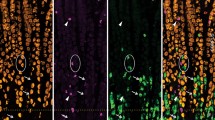Abstract
Gastrin-releasing enteroendocrine cells (G-cells) are usually described as flask-shaped cells with a large base and a small apical pole, integrated in the epithelium lining the basal region of the antral invaginations in the stomach. By means of a transgenic mouse line in which the enhanced version of GFP is endogenously expressed under the control of a gastrin promoter, we have analyzed the spatial distribution and morphological features of G-cells. We found that G-cells were not only located at the basal region of the invagination but to a lesser extent also at the upper region. Visualization of the entire cellular morphology revealed that G-cells show complex morphologies. Basally located G-cells are roundish-shaped cells which project a prominent apical process towards the lumen and extend basal protrusions containing the hormone gastrin that were frequently found in close proximity to blood vessels and occasionally in the vicinity of nerve fibers. Inspection of G-cells in the upper region of antral invaginations disclosed a novel population of G-cells. These cells have a spindle-like contour and long apical and basal processes which extend vertically along the antral invagination, parallel to the lumen. This G-cell population seems to be in contact with a network of nerve fibers. While the functional role of these untypical G-cells is still elusive, the results of this study provide some useful indications to possible roles of these G-cells.









Similar content being viewed by others
References
Alumets J, Ekelund M, El Munshid HA et al (1979) Topography of somatostatin cells in the stomach of the rat: possible functional significance. Cell Tissue Res 202:177–188
Bohórquez DV, Chandra R, Samsa LA et al (2011) Characterization of basal pseudopod-like processes in ileal and colonic PYY cells. J Mol Histol 42:3–13
Bohórquez DV, Samsa LA, Roholt A et al (2014) An enteroendocrine cell – enteric glia connection revealed by 3D electron microscopy. PLoS ONE 9, e89881
Bohórquez DV, Shahid RA, Erdmann A et al (2015) Neuroepithelial circuit formed by innervation of sensory enteroendocrine cells. J Clin Invest 125:782–786
Brighton CA, Rievaj J, Kuhre RE et al (2015) Bile acids trigger GLP-1 release predominantly by accessing basolaterally located G protein–coupled bile acid receptors. Endocrinology 156:3961–3970
Chandra R, Samsa LA, Vigna SR, Liddle RA (2010) Pseudopod-like basal cell processes in intestinal cholecystokinin cells. Cell Tissue Res 341:289–297
DeLisser HM, Baldwin HS, Albelda SM (1997) Platelet endothelial cell adhesion molecule 1 (PECAM-1/CD31): a multifunctional vascular cell adhesion molecule. Trends Cardiovasc Med 7:203–210
El-Salhy M, Gundersen D, Hatlebakk JG, Hausken T (2012) High densities of serotonin and peptide YY cells in the colon of patients with lymphocytic colitis. World J Gastroenterol 18:6070–6075
Forssmann WG, Orci L (1969) Ultrastructure and secretory cycle of the gastrin-producing cell. Z Zellforsch Mikrosk Anat 101:419–432
Gregory H, Hardy PM, Jones DS et al (1964) The antral hormone gastrin: structure of gastrin. Nature 204:931–933
Gribble FM, Reimann F (2016) Enteroendocrine cells: chemosensors in the intestinal epithelium. Annu Rev Physiol 78:277–299
Gunawardene AR, Corfe BM, Staton CA (2011) Classification and functions of enteroendocrine cells of the lower gastrointestinal tract. Int J Exp Pathol 92:219–231
Haid D, Widmayer P, Breer H (2011) Nutrient sensing receptors in gastric endocrine cells. J Mol Histol 42:355–364
Haid DC, Jordan-Biegger C, Widmayer P, Breer H (2012) Receptors responsive to protein breakdown products in G-cells and D-cells of mouse, swine and human. Front Physiol 3:65
Kapur SP (1982) A study of two enteroendocrine cells in the duodenum of the gerbil-Meriones unguiculatus. Cells Tissues Organs 112:97–104
Keast JR, Furness JB, Costa M (1985) Distribution of certain peptide-containing nerve fibers and endocrine cells in the gastrointestinal mucosa in five mammalian species. J Comp Neurol 236:403–422
Ku SK, Lee JH, Lee HS, Park KD (2002) The regional distribution and relative frequency of gastrointestinal endocrine cells in SHK-1 hairless mice: an immunohistochemical study. Anat Histol Embryol 31:78–84
Larsson LI (2000) Developmental biology of gastrin and somatostatin cells in the antropyloric mucosa of the stomach. Microsc Res Tech 48:272–281
Larsson LI, Goltermann N, de Magistris L et al (1979) Somatostatin cell processes as pathways for paracrine secretion. Science 205:1393–1395
Lechago J, Barajas L (1981) Innervation of rat antral gastrin-producing cells. Anat Rec 200:309–313
Mace OJ, Tehan B, Marshall F (2015) Pharmacology and physiology of gastrointestinal enteroendocrine cells. Pharmacol Res Perspect 3, e00155
Pais R, Gribble FM, Reimann F (2016) Signalling pathways involved in the detection of peptones by murine small intestinal enteroendocrine L-cells. Peptides 77:9–15
Pearse AGE, Bussolati G (1972) The identification of gastrin cells as G cells. Virchows Arch A 355:99–104
Reimann F, Habib AM, Tolhurst G et al (2008) Glucose densing in L vells: a primary cell study. Cell Metab 8:532–539
Rettenberger AT, Schulze W, Breer H, Haid D (2015) Analysis of the protein related receptor GPR92 in G-cells. Front Physiol 6:261
Sachs G, Zeng N, Prinz C (1997) Physiology of isolated gastric endocrine cells. Annu Rev Physiol 59:243–256
Takaishi S, Shibata W, Tomita H et al (2011) In vivo analysis of mouse gastrin gene regulation in enhanced GFP-BAC transgenic mice. Am J Physiol Gastrointest Liver Physiol 300:G334–G344
Uvnäs-Wallenstein K, Palmblad J (1980) Effect of food deprivation (fasting) on plasma gastrin levels in man. Scand J Gastroenterol 15:187–191
Verkijk M, Gielkens HAJ, Lamers CBHW, Masclee AAM (1998) Effect of gastrin on antroduodenal motility: role of intraluminal acidity. Am J Physiol Gastrointest Liver Physiol 275:G1209–G1216
Wang Y, Chandra R, Samsa LA et al (2011) Amino acids stimulate cholecystokinin release through the Ca(2+)-sensing receptor. Am J Physiol Gastrointest Liver Physiol 300:G528–G537
Acknowledgments
The authors thank Kerstin Bach for excellent technical assistance and Dr. Timothy C. Wang for providing the mGas-EGFP mice. This work was supported by the Deutsche Forschungsgemeinschaft, BR 712/25-1.
Author information
Authors and Affiliations
Corresponding author
Additional information
Claudia Frick and Amelie Therese Rettenberger contributed equally to this work.
Rights and permissions
About this article
Cite this article
Frick, C., Rettenberger, A.T., Lunz, M.L. et al. Complex morphology of gastrin-releasing G-cells in the antral region of the mouse stomach. Cell Tissue Res 366, 301–310 (2016). https://doi.org/10.1007/s00441-016-2455-1
Received:
Accepted:
Published:
Issue Date:
DOI: https://doi.org/10.1007/s00441-016-2455-1




